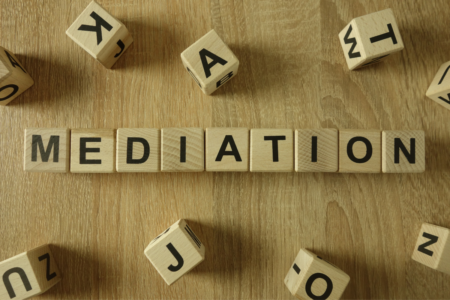The heart of the mediation process is the caucus session, where the mediator meets in private with each party to discuss case strengths and weaknesses and shuttles offers back and forth. Here is what you can expect.
- Negotiations are Time-Consuming. In a typical mediation, the joint opening session lasts an hour. The parties then retreat to caucus rooms to meet with the mediator in private and exchange offers for the remainder of the mediation. Negotiations can take as little as two hours but as many as twelve hours, depending on case complexity and the styles of both the mediator and attorneys. Half the time, the mediator will be meeting with the other party and you will be stuck waiting in your caucus room. Bring a book or some other form of entertainment and try to relax.
- Many Offers are Exchanged. Typically, there will be six to twenty offers made in total by two parties in a single mediation. Importantly, this means your first offer is typically nowhere close to your final offer. So try not to get excited about the first offer made by your legal team. Nor should you be too disappointed with the first offer made by the opposing party. Also, the ultimate settlement amount is typically much closer to the defendant’s opening offer than the plaintiff’s. Indeed, a case that settles for $200,000 likely began with a plaintiff’s opening offer of $800,000 and a defense opening offer of $50,000. Why? Because the plaintiff can start with the highest number imaginable for that type of case, and a defendant cannot start below zero.
- Impasses are Common and Often Broken with Bracket Offers. Do not lose hope if hours pass with no real movement. Parties move cautiously out of concern for ceding too much ground, too quickly. As the threat of an impasse grows, mediators commonly utilize bracket offers to jumpstart negotiations. A bracket offer is a contingent offer. For example, if the plaintiff’s fourth conventional offer is $1 million, and the defendant’s fourth conventional offer is $300,000, the plaintiff may attempt to bridge the gap by making a bracket offer of $750,000 and $500,000, meaning the plaintiff will move from $1 million to $750,000 million but only if the defendant will move from $300,000 to $500,000. It is rare for a bracket to be accepted. Instead, the receiving party responds by making their own bracket offer. In this example, the defendant might respond with its own bracket of $400,000 and $700,000. The most important number in a bracket offer is usually not the top and bottom numbers of the bracket. Instead, it is the “midpoint” of these two numbers. Why? Because a bracket offer is a strong message that the offering party is willing to settle for the midpoint of the proposed bracket. In our example, the plaintiff’s bracket communicates a willingness to settle for $625,000 million, and the defendant’s bracket communicates a willingness to settle for $550,000. The gap has now shrunk from $700,000 ($1 million minus $300,000) to $75,000 ($625,000 minus $550,000). With this critical information in hand, the parties usually revert to conventional offers within their proposed bracket ranges, and in most instances the final settlement amount is between the established bracket midpoints.
- When All Else Fails, You Might Receive a Mediator Proposal. Most mediators are rightfully hesitant to suggest a settlement amount to the parties. Indeed, the entire purpose of the mediation is to explore each party’s views in an effort to have them reach an agreement of their own making. When all else fails, however, the mediator may make a proposal to settle the case as a last-ditch effort. Carefully considering all of the information imparted by the parties concerning their positions, the mediator will determine a proposed settlement amount with the most realistic chance of being agreed to by both parties. The settlement amount is typically not the mediator’s personal view of what the case is worth. Instead, it is the mediator’s assessment of the farthest each party is willing to stretch to settle the case. The mediator presents this proposal in a double blind method, where each party privately votes yes or no, and the mediator only reveals the votes if both parties say yes. As a result, if either or both parties reject the mediator proposal, they never know whether the opposing party accepted it.
In conclusion, the actual parties to a legal dispute are the most important people in the room at mediation. We hope this three-part series prepares clients for their upcoming mediations. For a deeper dive, check out the remainder of our blogs, for whom the core audience is mediators and attorneys.






